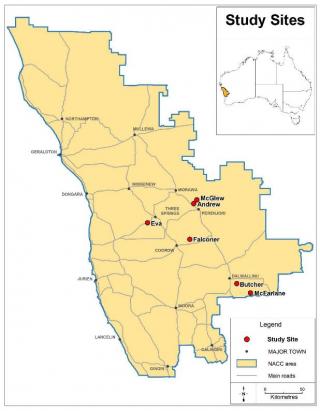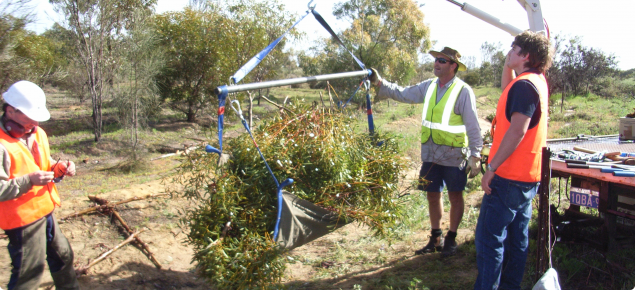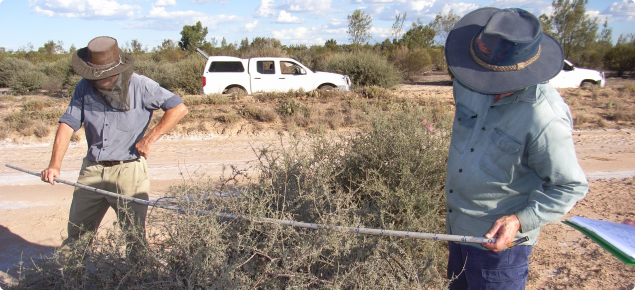How do we know the potential for carbon sequestration on saline land?
The State Natural Resource Management Program funded a collaborative project between the Department of Agriculture and Food, Western Australia (now part of the Department of Primary Industries and Regional Development), the Northern Agricultural Catchments Council and the Forest Products Commission to investigate carbon sequestration opportunities and risks on saline land.
More than 1 million hectares of agricultural land in Western Australia are either saline or at risk from rising saline watertables, and there are opportunities to improve productivity and profit on some of this area.
This page summarises a report from a project that measured carbon sequestration in trees and shrubs on and around salt-affected land in the Northern Agricultural Region.
What did the project do?
The collaborators:
- selected 9 sites to measure across 6 farms (Figure 1)
- established 237 sample plots across the sites
- measured apparent salinity (ECa) on all the plots with a Geonics EM38 instrument
- measured 5170 trees and shrubs to estimate the biomass volume
- harvested 313 trees and shrubs to directly measure biomass weight and calculate carbon content
- calculated carbon stocks for each site.

What did the project find?
Saline areas can sequester substantial amounts of carbon, depending on access to moisture and use of salt tolerant species.
- Across all sites, carbon stocks in the revegetation decreased with increasing salinity beyond ECa 200 millisiemens per metre (mS/m).
- For salinity less than ECa 200 mS/m (highly saline and less), the average tree carbon stocks at age 15 years (TC15) was the equivalent of 42 tonnes of carbon dioxide per hectare (t CO2/ha).
- For salinity in the range ECa 200–299 mS/m (severely saline), TC15 declined to 29 t CO2/ha (68%) in the sample plots.
- For salinity greater than ECa 300 mS/m (severely to extremely saline), TC15 declined to 12 t CO2/ha (29%) in the sample plots.
- There was considerable variation in carbon sequestration between species and planting layouts: from 121 t CO2/ha after 23 years on an alley planting of trees (average of 5.26 t/ha/y) to 8 t CO2/ha after 11 years (0.73 t/ha/y) on a grazed saltbush paddock.
- Revegetated saline areas provides other land use benefits, including wildlife habitat, mitigating land degradation, and providing fodder reserves for grazing. These were not measured during the project.
- Our data was generally estimating higher rates of carbon sequestration than the Full Carbon Accounting Model (FullCAM) is suggesting. FullCAM is the calculation engine which supports the estimation of carbon stock change in Australia’s forest and agricultural systems.
What do the findings mean?
The results indicate that saline land at certain salinity levels has the potential to sequester significant amounts of carbon. The results also indicate that saline land in the northern agricultural areas of Western Australia may sequester more carbon than FullCAM used at the time of the project.





